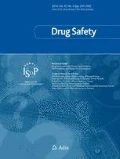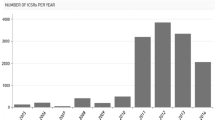Abstract
A medication error is an unintended failure in the drug treatment process that leads to, or has the potential to lead to, harm to the patient. Reducing the risk of medication errors is a shared responsibility between patients, healthcare professionals, regulators and the pharmaceutical industry at all levels of healthcare delivery. In 2015, the EU regulatory network released a two-part good practice guide on medication errors to support both the pharmaceutical industry and regulators in the implementation of the changes introduced with the EU pharmacovigilance legislation. These changes included a modification of the ‘adverse reaction’ definition to include events associated with medication errors, and the requirement for national competent authorities responsible for pharmacovigilance in EU Member States to collaborate and exchange information on medication errors resulting in harm with national patient safety organisations. To facilitate reporting and learning from medication errors, a clear distinction has been made in the guidance between medication errors resulting in adverse reactions, medication errors without harm, intercepted medication errors and potential errors. This distinction is supported by an enhanced MedDRA® terminology that allows for coding all stages of the medication use process where the error occurred in addition to any clinical consequences. To better understand the causes and contributing factors, individual case safety reports involving an error should be followed-up with the primary reporter to gather information relevant for the conduct of root cause analysis where this may be appropriate. Such reports should also be summarised in periodic safety update reports and addressed in risk management plans. Any risk minimisation and prevention strategy for medication errors should consider all stages of a medicinal product’s life-cycle, particularly the main sources and types of medication errors during product development. This article describes the key concepts of the EU good practice guidance for defining, classifying, coding, reporting, evaluating and preventing medication errors. This guidance should contribute to the safe and effective use of medicines for the benefit of patients and public health.





Similar content being viewed by others
Notes
MedDRA®, the Medical Dictionary for Regulatory Activities, is the international medical terminology developed under the auspices of the International Conference on Harmonisation of Technical Requirements for Registration of Pharmaceuticals for Human Use (ICH). The MedDRA® trademark is owned by the International Federation of Pharmaceutical Manufacturers and Associations (IFPMA) on behalf of ICH.
ISO 14971—medical devices—application of risk management http://www.iso.org/iso/iso_catalogue/catalogue_ics/catalogue_detail_ics.htm?csnumber=38193.
IEC62366—medical devices—application of usability engineering to medical devices http://www.iso.org/iso/catalogue_detail.htm?csnumber=38594.
A safety signal is information on a new or known adverse event that is potentially caused by a medicine and that warrants further investigation. Signals are generated from several sources, such as spontaneous reports, clinical studies and the scientific literature.
References
World Health Organization. Reporting and learning systems for medication errors: the role of pharmacovigilance centres. 2014. Available from: http://www.who.int/medicines/areas/quality_safety/safety_efficacy/emp_mes/en. Accessed 27 Nov 2015.
Howard R, Avery A, Slavenburg S, Royal S, Pipe G, Lucassen P, Pirmohamed M. Which drugs cause preventable admissions to hospital? A systematic review. Br J Clin Pharmacol. 2007;63(2):136–47.
Dean B, Schachter M, Vincent C, Barber N. Prescribing errors in hospital inpatients: their incidence and clinical significance. Qual Saf Health Care. 2002;11(4):340–4.
Shah S, Aslam M, Avery A. A survey of prescription errors in general practice. Pharm J. 2001;267:860–2.
Recio Blázquez M, López Ruiz M, Arias Fernández L, Zamora Barrios M. Analysis of medication errors detected in the dispensing process by the unit dose system in a Spanish hospital. Eur J Hosp Pharm. 2004;1:20–5.
Beso A, Franklin B, Barber N. The frequency and potential causes of dispending errors in a hospital pharmacy. Pharm World Sci. 2005;27(3):182–90.
Chua S, Wong I, Edmondson H, Allen C, Chow J, Peacham J, et al. A feasibility study for recording of dispensing errors and near misses in four UK primary care pharmacies. Drug Saf. 2003;26(11):803–13.
Union European. Directive 2010/84/EU of the European Parliament and of the council of 15 December 2010 amending, as regards pharmacovigilance, Directive 2001/83/EC on the Community code relating to medicinal products for human use. OJ. 2010;53(L348):74–99.
Union European. Directive 2001/83/EC of the European Parliament and of the Council of 6 November 2001 on the Community code relating to medicinal products for human use. OJ. 2001;44(L311):67–128.
European Medicines Agency. Medication-errors workshop report (EMA/144458/2013). 2013. Available from: http://www.ema.europa.eu/docs/en_GB/document_library/Report/2013/05/WC500143163.pdf. Accessed 27 Nov 2015.
European Medicines Agency. Medication errors—follow-up actions from workshop (EMA/20791/2014). 2014. Available from: http://www.ema.europa.eu/docs/en_GB/document_library/Other/2014/04/WC500165496.pdf. Accessed 27 Nov 2015.
European Commission. Patient Safety Policy: EU Patient Safety and Quality of Care Expert Group. 2016. Available from: http://ec.europa.eu/health/patient_safety/policy/index_en.htm. Accessed 27 Jan 2016.
Reporting and learning subgroup of the European Commission Patient Safety Quality of Care Working Group. Key findings and recommendations on reporting and learning systems for patient safety incidents across Europe. 2014. Available from: http://ec.europa.eu/health/patient_safety/docs/guidelines_psqcwg_reporting_learningsystems_en.pdf. Accessed 27 Nov 2015.
Pharmacovigilance Risk Assessment Committee. Good practice guide on recording, coding, reporting and assessment of medication errors (EMA/762563/2014). 2015. Available from: http://www.ema.europa.eu/docs/en_GB/document_library/Regulatory_and_procedural_guideline/2015/11/WC500196979.pdf. Accessed 27 Nov 2015.
Pharmacovigilance Risk Assessment Committee. Good practice guide on risk minimisation and prevention of medication errors (EMA/606103/2014). 2015. Available from: http://www.ema.europa.eu/docs/en_GB/document_library/Regulatory_and_procedural_guideline/2015/11/WC500196981.pdf. Accessed 27 Jan 2016.
European Medicines Agency. Good pharmacovigilance practices. 2016. Available from: http://www.ema.europa.eu/ema/index.jsp?curl=pages/regulation/document_listing/document_listing_000345.jsp&mid=WC0b01ac058058f32c. Accessed 27 Jan 2016.
Cousins D, Gerrett D, Richards N, Jadeja M. Initiatives to identify and mitigate medication errors in England. Drug Saf. 2015;38(4):349–57.
International Council for Harmonisation of Technical Requirements for Registration of Pharmaceuticals for Human Use (ICH). Medical Dictionary for Regulatory Activities (MedDRA). 2016. Available from: http://www.meddra.org. Accessed 27 Jan 2016.
Council for International Organisations of Medical Sciences. CIOMS Working Group on Standardised MedDRA Queries (SMQs). 2016. Available from: http://www.cioms.ch/index.php/2012-06-10-08-47-53/working-groups/meddra-smqs. Accessed 27 Jan 2016.
US Food and Drug Administration Center for Drug Evaluation and Research (CDER). Safety considerations for product design to minimize medication errors. 2012. Available from: http://www.fda.gov/downloads/Drugs/GuidanceComplianceRegulatoryInformation/Guidances/UCM331810.pdf. Accessed 27 Jan 2016.
US Food and Drug Administration Center for Drug Evaluation and Research (CDER). Safety considerations for container labels and carton labeling design to minimize medication errors. 2012. Available from: http://www.fda.gov/downloads/Drugs/GuidanceComplianceRegulatoryInformation/Guidances/UCM349009.pdf. Accessed 27 Jan 2016.
Pirmohamed M, James S, Meakin S, Green C, Scott A, Walley T, et al. Adverse drug reactions as cause of admissions to hospital: prospective analysis of 18,820 patients. BMJ. 2004;329(7456):15–9.
Manias E, Kinney S, Cranswick N, Williams A. Medication errors in hospitalised children. J Paediatr Child Health. 2014;50(1):71–7.
Bolt R, Yates J, Mahon J, Bakri I. Evidence of frequent dosing errors in paediatrics and intervention to reduce such prescribing errors. J Clin Pharm Ther. 2014;39(1):78–83.
Padden Elliot J, McConaha J, Bunk E, Hilton L, Modany A, Bucker I. Influence of viscosity and consumer use on accuracy of oral medication dosing devices. J Pharm Tech. 2014;30(4):111–7.
Pharmacovigilance Risk Assessment Committee. Risk minimisation strategy for high-strength and fixed-combination insulin products. Addendum to the good practice guide on risk minimisation and prevention of medication errors (EMA/686009/2014). 2015. Available from: http://www.ema.europa.eu/docs/en_GB/document_library/Regulatory_and_procedural_guideline/2015/11/WC500196980.pdf. Accessed 18 Dec 2015.
Committee for Medicinal Products for Human Use. Guideline on the acceptability of names for human medicinal products processed through the centralised procedure (EMA/CHMP/287710/2014 - Rev. 6). 2014. Available from: http://www.ema.europa.eu/docs/en_GB/document_library/Regulatory_and_procedural_guideline/2014/06/WC500167844.pdf. Accessed 27 Nov 2015.
Committee for Human Medicinal Products. Mandate, objectives and rules of procedure for the Name Review Group (NRG) (EMA/411943/2014). 2014. Available from: http://www.ema.europa.eu/docs/en_GB/document_library/Other/2014/07/WC500169642.pdf. Accessed 27 Nov 2015.
European Medicines Agency. Recommendations on medication errors. 2016. Available from: http://www.ema.europa.eu/ema/index.jsp?curl=pages/regulation/document_listing/document_listing_000398.jsp&mid=WC0b01ac058098f1c0. Accessed 27 Jan 2016.
Medicines and Healthcare products Regulatory Agency. The strengthening collaboration for operating pharmacovigilance in Europe (SCOPE) joint action. 2016. Available from: http://www.scopejointaction.eu. Accessed 27 Nov 2015.
NHS England. Patient Safety Alert (NHS/PSA/D/2014/005): Improving medication error incident reporting and learning. 2014. Available from: http://www.england.nhs.uk/wp-content/uploads/2014/03/psa-med-error.pdf. Accessed 28 Jan 2016.
Acknowledgments
The authors thank the members of the PRAC for their active support throughout the development of the EU good practice guide on medication errors and the members of the European Commission’s Patient Safety and Quality of Care Expert Group for their useful contribution to the guidance.
Author information
Authors and Affiliations
Corresponding author
Ethics declarations
Funding
No sources of funding were used to assist in the preparation of this article.
Conflict of interest
Thomas Goedecke, Kathryn Ord, Victoria Newbould, Sabine Brosch and Peter Arlett have no conflicts of interest that are directly relevant to the content of this article.
Additional information
Rights and permissions
About this article
Cite this article
Goedecke, T., Ord, K., Newbould, V. et al. Medication Errors: New EU Good Practice Guide on Risk Minimisation and Error Prevention. Drug Saf 39, 491–500 (2016). https://doi.org/10.1007/s40264-016-0410-4
Published:
Issue Date:
DOI: https://doi.org/10.1007/s40264-016-0410-4




